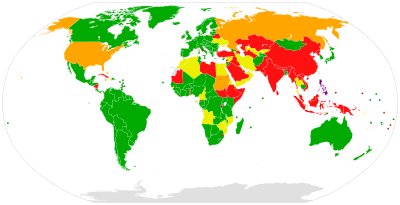Rome Statute facts for kids
| Rome Statute of the International Criminal Court | |
|---|---|

Parties and signatories of the Statute
State party
Signatory that has not ratified State party that subsequently withdrew its membership Signatory that subsequently withdrew its signature Non-party, non-signatory |
|
| Drafted | 17 July 1998 |
| Signed | 17 July 1998 |
| Location | Rome, Italy |
| Effective | 1 July 2002 |
| Condition | 60 ratifications |
| Signatories | 139 |
| Parties | 123 |
| Depositary | UN Secretary-General |
| Languages | Arabic, Chinese, English, French, Russian and Spanish |
The Rome Statute of the International Criminal Court is an important treaty. It created the International Criminal Court (ICC). This court helps deal with very serious international crimes. The treaty was agreed upon in Rome, Italy, on July 17, 1998. It officially started on July 1, 2002.
As of November 2019, 123 countries have agreed to follow this treaty. The Rome Statute explains how the court works. It also defines what crimes the court can investigate. It sets up the court's structure too.
The Rome Statute lists four main international crimes. These are genocide, crimes against humanity, war crimes, and the crime of aggression. These crimes have no time limit for prosecution. This means people can be charged for them at any time. The ICC can only investigate these crimes if countries cannot or will not do it themselves. The court's power works alongside national courts. It does not replace them. The court can only handle crimes that happened in a country that signed the treaty. Or, if the person who committed the crime is from a country that signed it. Sometimes, the United Nations Security Council can also ask the ICC to get involved.
Contents
What the Rome Statute Does
The Rome Statute set up the International Criminal Court. This court was created to prosecute individuals. These individuals are accused of very serious international crimes. These crimes include genocide, crimes against humanity, war crimes, and the crime of aggression.
For many years, countries talked about creating a permanent international court. This court would handle these terrible crimes. In June 1998, the United Nations General Assembly held a meeting in Rome. The goal was to finish and adopt the agreement. This agreement would establish the International Criminal Court.
How the Rome Statute Started
Early Ideas for a World Court
The Rome Statute came about after many tries to create a global court. People wanted a court that could judge crimes across borders. In the late 1800s, countries started thinking about permanent international courts. At the Hague Conferences in 1899 and 1907, powerful nations tried to agree on rules for war. They also wanted to limit new weapons.
After World War I and especially after World War II, it became very important. People wanted to punish those responsible for awful crimes. These crimes were so bad they were called "crimes against humanity."
The Nuremberg trials were a key moment in legal history. After these trials, some agreements were signed. These agreements helped lead to the Rome Statute.
In 1948, the UN General Assembly passed a resolution. It was about preventing and punishing genocide. This was a first step towards a permanent international criminal court. The resolution hoped the UN legal team would work on this.
The UN General Assembly then created a committee. This committee was to draft a statute and study legal issues. A first draft was ready in 1951, and a second in 1955. But there were many delays. One reason was how hard it was to define the crime of aggression. World politics during the Cold War also slowed things down.
In 1989, Trinidad and Tobago asked the UN to restart talks. They wanted to create an international criminal court. In 1994, they presented a draft. The General Assembly then created a special committee. This committee worked for two years (1996–1998) on the draft.
During this time, the United Nations also set up special courts. These were for crimes in the former Yugoslavia (ICTY) and Rwanda (ICTR). The rules for these courts were quite similar to what became the Rome Statute.
Setting Up the Court
The UN General Assembly decided to hold a special meeting. This meeting would finalize the agreement for an international criminal court. The meeting took place in Rome from June 15 to July 17, 1998.
Representatives from 161 countries attended. Observers from other groups were there too. These included human rights organizations. The meeting was held at the Food and Agriculture Organization building. On July 17, 1998, the Rome Statute was adopted. The vote was 120 countries in favor, 7 against, and 21 abstaining.
We know for sure that China, Israel, and the United States voted against the treaty. They publicly confirmed their votes.
On April 11, 2002, ten countries officially approved the statute. This happened at a special event at the United Nations in New York City. This brought the total number of countries to sixty. Sixty was the minimum number needed for the treaty to start. The treaty officially began on July 1, 2002. The ICC can only prosecute crimes that happened on or after this date.
The countries that signed the treaty held a meeting in Kampala, Uganda, in 2010. At this meeting, they agreed on a definition for the crime of aggression. This allowed the ICC to deal with this crime for the first time. They also added more types of actions to the list of war crimes.
Countries that are Part of the Statute
How the Court Works
The Rome Statute explains how the ICC is set up. It also details what crimes it can handle. The ICC can only prosecute individuals, not countries or organizations. It focuses on four types of crimes: genocide, crimes against humanity, war crimes, and the crime of aggression. These crimes are described in detail in the Statute. They must have happened after July 1, 2002.
The ICC has power over these crimes in three situations:
- If the crimes happened in a country that is part of the Statute.
- If the crimes were committed by someone from a country that is part of the Statute.
- If the United Nations Security Council asks the ICC Prosecutor to investigate.
The ICC can start an investigation if the UN Security Council asks. Or, if a country that is part of the Statute requests it. Otherwise, the Prosecutor needs permission from a group of three judges. This group is called a Pre-Trial Chamber. The ICC does not recognize any special protection for officials. Even a head of state can be prosecuted. The only exception is that the ICC cannot prosecute anyone who was under 18 when the crime happened.
The Rome Statute created three main parts:
- The ICC itself.
- The Assembly of States Parties (ASP), which is like a meeting of all the countries that signed the treaty.
- The Trust Fund for Victims, which helps victims of the crimes.
The ICC itself has four main parts:
- The Presidency: This part handles mostly administrative tasks.
- The Divisions: These are the judges who handle different stages of cases (Pre-Trial, Trial, and Appeals).
- The Office of the Prosecutor: This office investigates and brings cases to court.
- The Registry: This part supports all the other parts of the court.
Any changes to the Rome Statute need approval from two-thirds of the countries that signed it. Most changes will not start until seven-eighths of the countries have approved them. If a country does not approve a change, it can leave the treaty right away. Changes to the list of crimes only apply to the countries that approve them. They do not need approval from seven-eighths of all countries.
See also
 In Spanish: Estatuto de Roma para niños
In Spanish: Estatuto de Roma para niños
- International Criminal Court Act 2001
- Völkerstrafgesetzbuch
- World Day for International Justice


